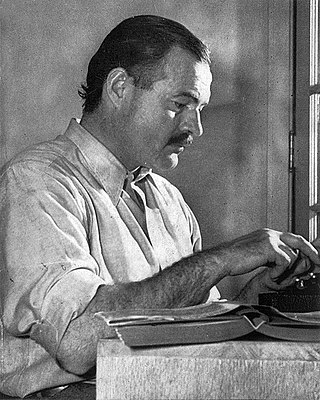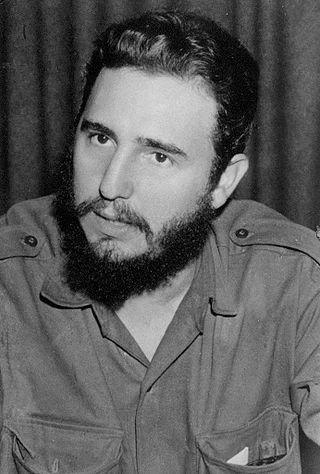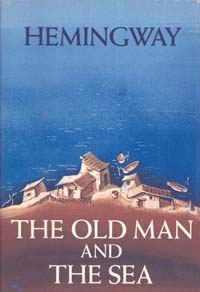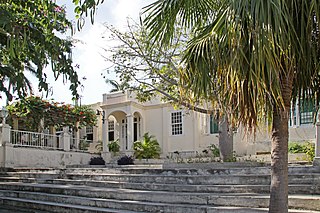
Ernest Miller Hemingway was an American novelist, short-story writer and journalist. Best known for an economical, understated style that significantly influenced later 20th-century writers, he is often romanticized for his adventurous lifestyle, and outspoken and blunt public image. Most of Hemingway's works were published between the mid-1920s and mid-1950s, including seven novels, six short-story collections and two non-fiction works. His writings have become classics of American literature; he was awarded the 1954 Nobel Prize in Literature, while three of his novels, four short-story collections and three nonfiction works were published posthumously.

Fidel Alejandro Castro Ruz was a Cuban revolutionary and politician who was the leader of Cuba from 1959 to 2008, serving as the prime minister of Cuba from 1959 to 1976 and president from 1976 to 2008. Ideologically a Marxist–Leninist and Cuban nationalist, he also served as the first secretary of the Communist Party of Cuba from 1965 until 2011. Under his administration, Cuba became a one-party communist state; industry and business were nationalized, and socialist reforms were implemented throughout society.

The Old Man and the Sea is a 1952 novella written by the American author Ernest Hemingway. Written between December 1950 and February 1951, it was the last major fictional work Hemingway published during his lifetime. It tells the story of Santiago, an aging fisherman, and his long struggle to catch a giant marlin. The novella was highly anticipated and was released to record sales; the initial critical reception was equally positive, but attitudes have varied significantly since then.

The Caribbean Series is an annual club tournament contested by professional baseball teams in Latin America. It is organized by the Caribbean Professional Baseball Confederation. The series is normally played in February, after the various winter leagues have ended their national tournaments.

A Moveable Feast is a 1964 memoir by American author Ernest Hemingway about his years as a struggling expatriate journalist and writer in Paris during the 1920s. It was published posthumously. The book details Hemingway's first marriage to Hadley Richardson and his associations with other cultural figures of the Lost Generation in Interwar France.

Finca Vigía is a house in San Francisco de Paula Ward in Havana, Cuba which was once the residence of Ernest Hemingway. Like Hemingway's Key West home, it is now a museum. The building was constructed in 1886.

The iceberg theory or theory of omission is a writing technique coined by American writer Ernest Hemingway. As a young journalist, Hemingway had to focus his newspaper reports on immediate events, with very little context or interpretation. When he became a writer of short stories, he retained this minimalistic style, focusing on surface elements without explicitly discussing underlying themes. Hemingway believed the deeper meaning of a story should not be evident on the surface, but should shine through implicitly.

Cuba, officially the Republic of Cuba, is an island country, comprising the island of Cuba, Isla de la Juventud, archipelagos, 4,195 islands and cays surrounding the main island. Cuba is located where the northern Caribbean Sea, Gulf of Mexico, and Atlantic Ocean meet. Cuba is located east of the Yucatán Peninsula (Mexico), south of both the American state of Florida and the Bahamas, west of Hispaniola, and north of Jamaica and the Cayman Islands. Havana is the largest city and capital. Cuba is the third-most populous country in the Caribbean after Haiti and the Dominican Republic, with about 11 million inhabitants. But also the largest country in the Caribbean.

Islands in the Stream (1970) is the first of the posthumously published novels of Ernest Hemingway. The book was originally intended to revive Hemingway's reputation after the negative reviews of Across the River and Into the Trees. He began writing it in 1950 and advanced greatly through 1951. The work, rough but seemingly finished, was found by Mary Hemingway among 332 works Hemingway left behind at his death. Islands in the Stream was meant to encompass three stories to illustrate different stages in the life of its main character, Thomas Hudson. The three different parts of the novel were originally to be titled "The Sea When Young", "The Sea When Absent" and "The Sea in Being". These titles were changed, however, into what are now its three acts: "Bimini", "Cuba", and "At Sea".
Christopher P. Baker is a professional travel writer and photographer, adventure motorcyclist, tour leader, and Cuba expert, and the 2008 Lowell Thomas Award 'Travel Journalist of the Year.' He is a contributor to magazines and other publications worldwide, and is the author of travel guidebooks for publishers such as Dorling Kindersley, Lonely Planet, Moon Publications, and National Geographic.
Hilary Hemingway is an American author. She grew up in Miami Beach, and, as of 2016, lives on Cape Coral.

Agencia de Noticias Latinoamericana S.A., trading as Prensa Latina, is the official state news agency of Cuba, founded in March 1959 shortly after the Cuban Revolution.
The Capablanca Memorial is a chess tournament that has been held annually in Cuba since 1962 in honor of José Raúl Capablanca y Graupera. At the time, it was the best paid tournament in the world. Since 1974 B and C tournaments have been held.

The Hotel Ambos Mundos is a hotel in Havana, Cuba. Built with a square form with five floors, it has an eclectic set of characteristics of 20th-century style architecture. It was built in 1924 on a site that previously had been occupied by an old family house on the corner of Calle Obispo and Mercaderes in Old Havana. It is a frequent tourist destination because it was home to the popular writer Ernest Hemingway for seven years in the 1930s.
Havana, Cuba, is a host city to numerous events and festivals.

Ernest Hemingway owned a 38-foot fishing boat named Pilar. It was acquired in April 1934 from Wheeler Shipbuilding in Brooklyn, New York, for $7,495.[1] "Pilar" was a nickname for Hemingway's second wife, Pauline, and also the name of the woman leader of the partisan band in his 1940 novel The Spanish Civil War, For Whom the Bell Tolls. Hemingway regularly fished off the boat in Key West, Florida, Marquesas Keys, and the Gulf Stream off the Cuban coast. He made three trips by boat to the Bimini Islands, wherein his fishing, drinking, and fighting exploits drew much attention and remain part of the island's history. In addition to fishing trips on Pilar, Hemingway contributed to scientific research, including collaboration with the Smithsonian Institution. Several of Hemingway's books were influenced by time spent on the boat, most notably The Old Man and the Sea (1953) and Islands in the Stream (1970). The yacht also inspired the name of Playa Pilar on Cayo Guillermo. The opening and other scenes in the 2012 film Hemingway & Gellhorn depict a miniature boat replica.

The Communist Party of Cuba is the sole ruling party of Cuba. It was founded on 3 October 1965 as the successor to the United Party of the Cuban Socialist Revolution, which was in turn made up of the 26th of July Movement and Popular Socialist Party that seized power in Cuba after the 1959 Cuban Revolution. The party governs Cuba as an authoritarian one-party state where dissidence and political opposition are prohibited and repressed. The Cuban constitution ascribes the role of the party to be the "leading force of society and of the state".

Papa: Hemingway in Cuba is a 2015 Canadian-American biographical film. It was written by Denne Bart Petitclerc, and directed by Bob Yari. The film is based on events from Ernest Hemingway's life in Havana, Cuba in the 1950s, and on a friendship that developed there between Hemingway and Petitclerc, who was then a young journalist. The film received generally unfavorable reviews.
Osvaldo Eustasio Salas Freire, was a Cuban-American photographer, remembered for his famous image of Ernest Hemingway and Fidel Castro in Cuba, circa 1960, and for his prolific documentation of American Major League Baseball—and, in particular, the influx of minority players—during the 1950s, all of which now resides in the collection of the National Baseball Hall of Fame.













